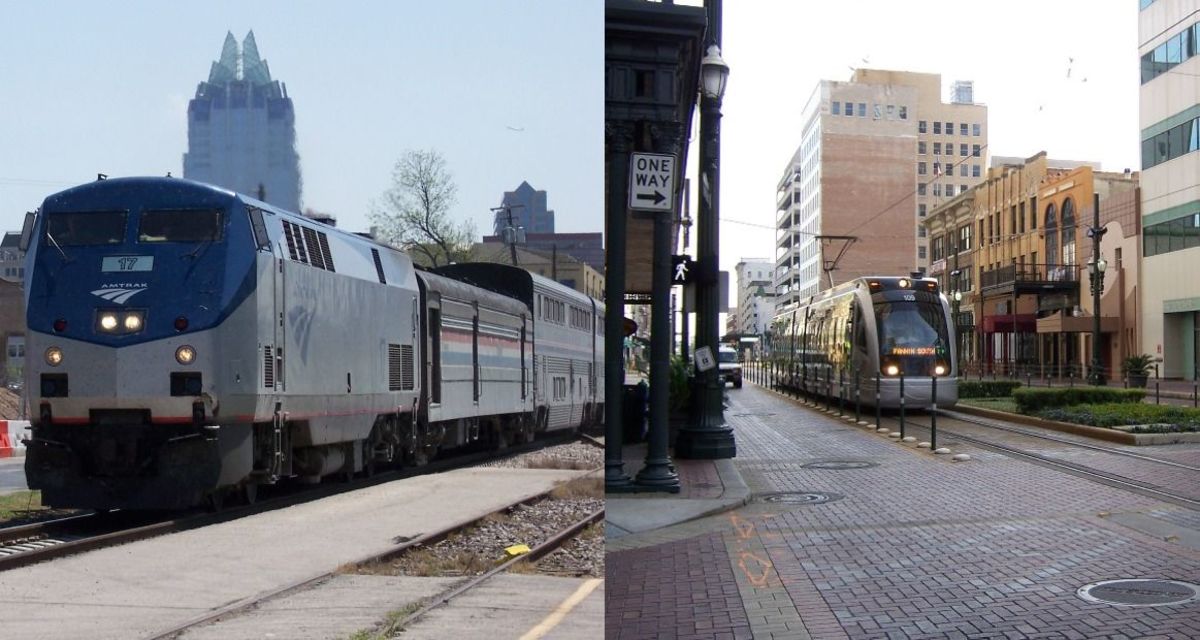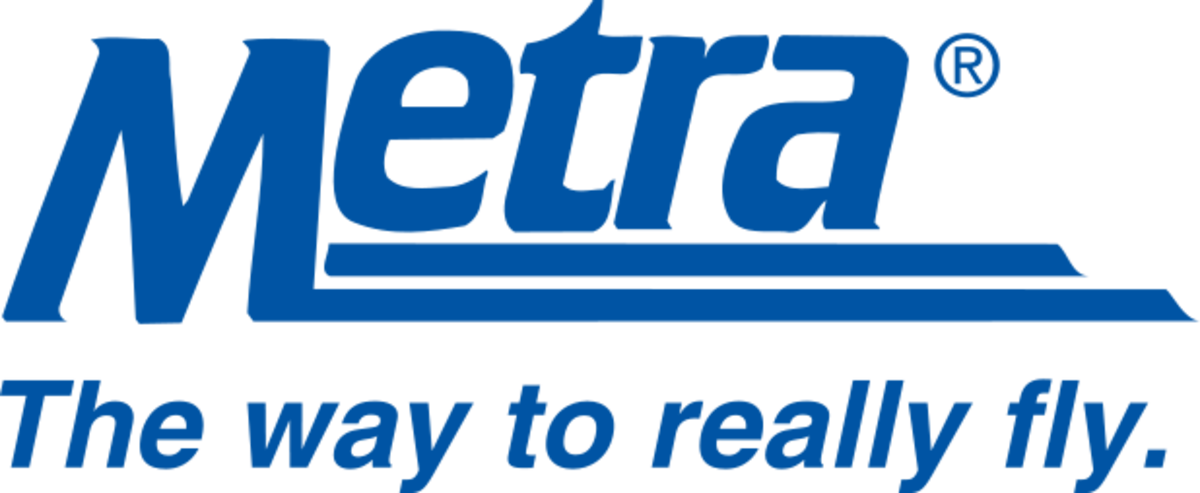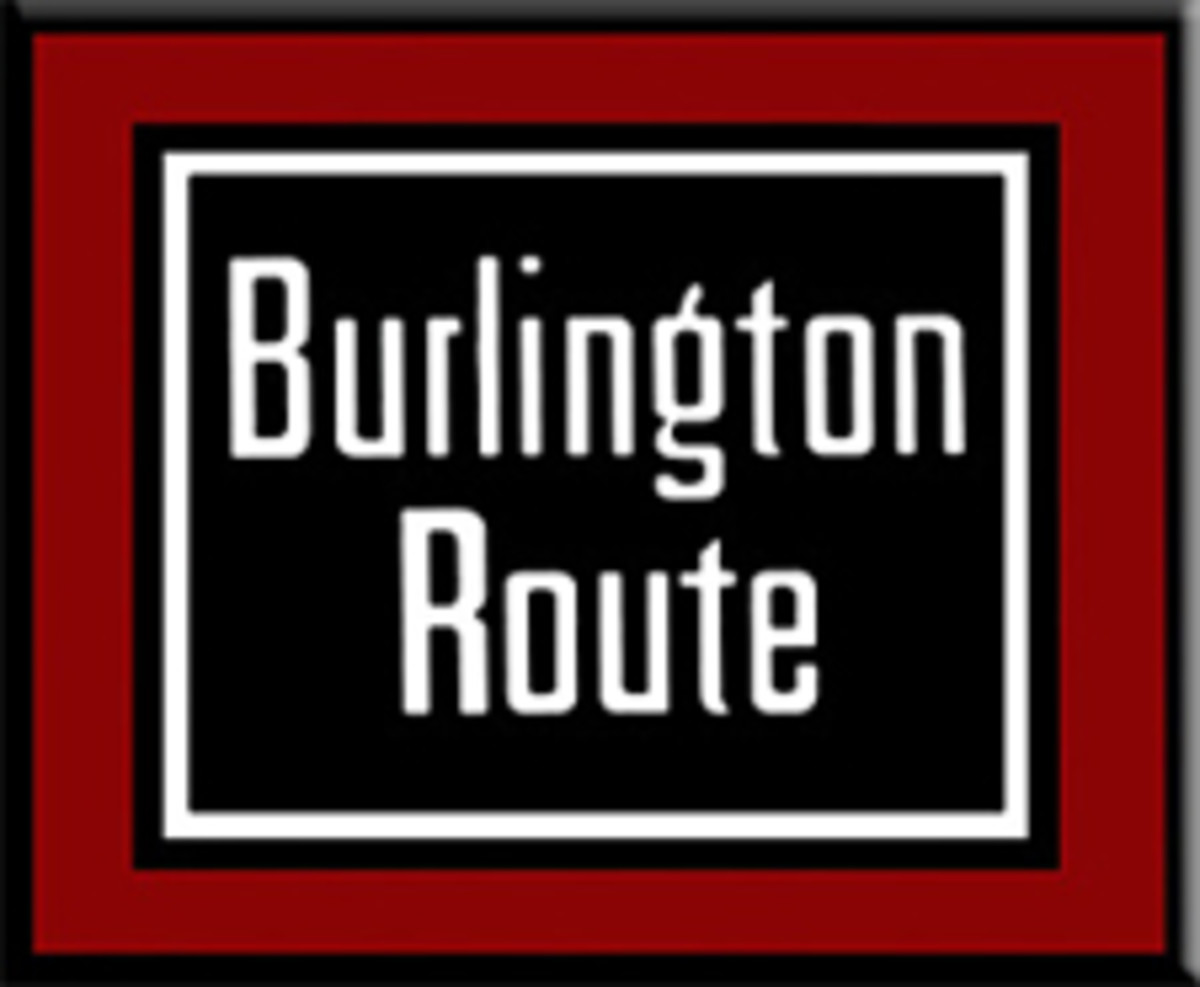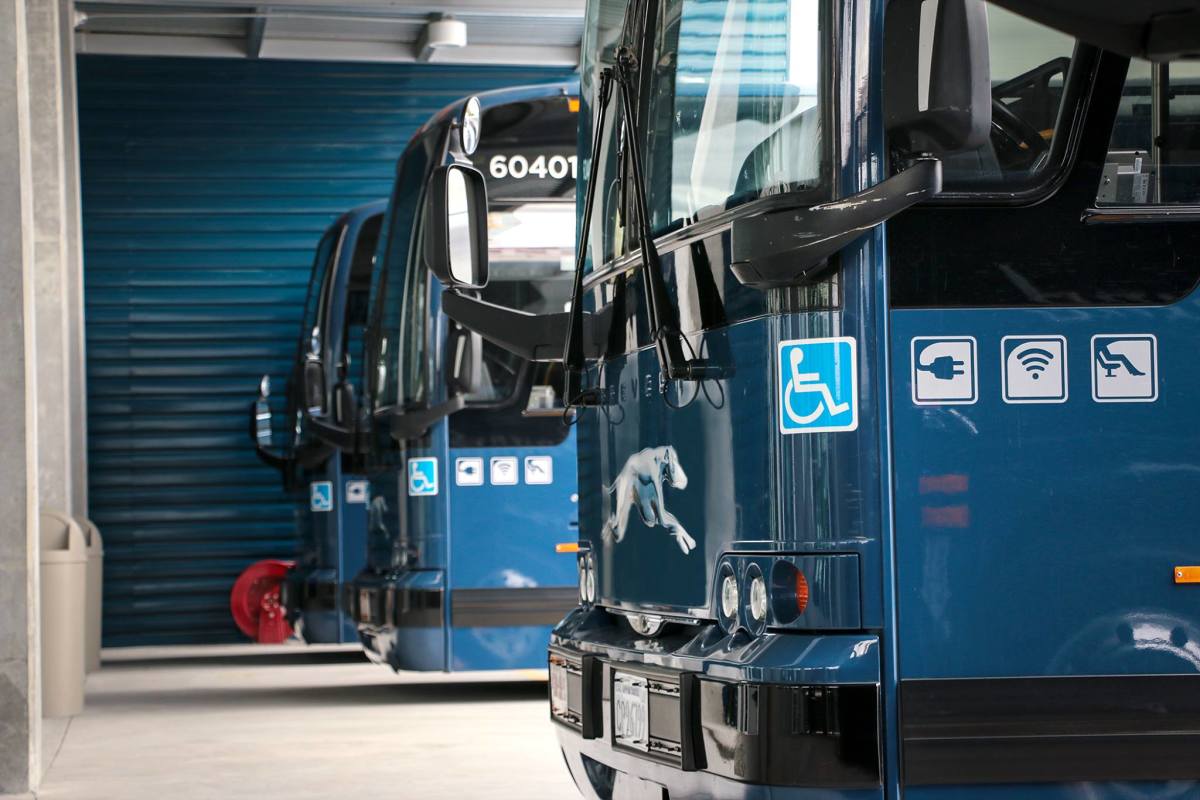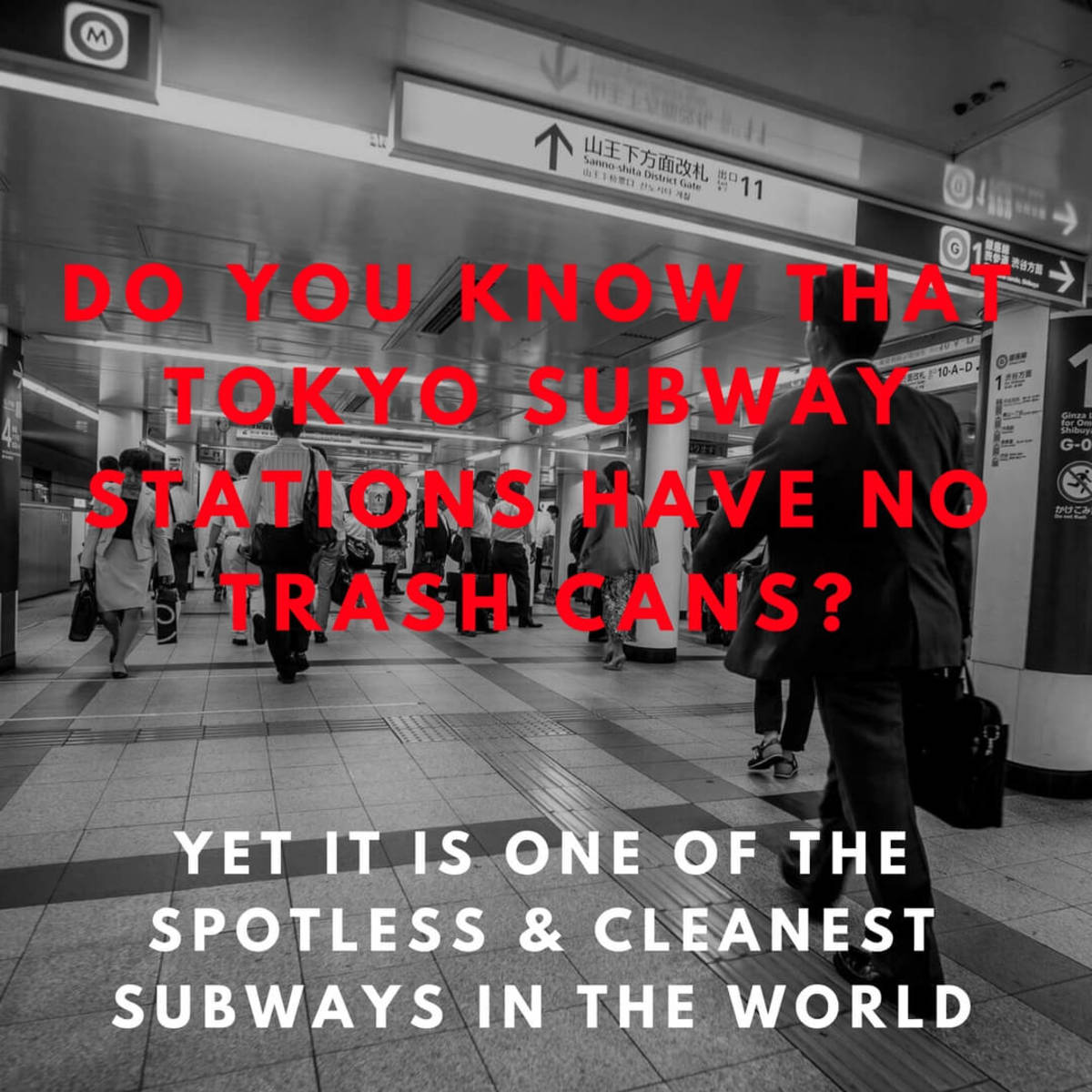Faster U.S. Surface Transit Raises Need for Public Rail Safety Awareness
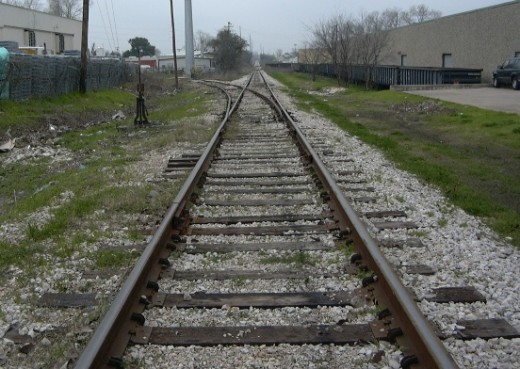
Here in the USA, fast, surface-routed transit may be coming to a city near you! Actually, read that as "may be returning " ... because America's cities and metro regions once already had fast surface transit — mainly, urban streetcar and interurban electric rail trolley lines — until they were eliminated, converted to much slower motor buses, and ripped out from the late 1920s to the early 1960s (some transit historians and advocates refer to that as the Transit Devastation era).
In any case, electric light rail transit (LRT), regional passenger rail ("commuter rail"), and "bus rapid transit" (buses running fast on dedicated urban paveways and busways) are intrepidly returning to urban cityscapes. In addition, Amtrak's intercity rail passenger operations — which overwhelmingly use surface alignments through urban and suburban areas — may be gradually increased in both speed and frequency on some routes in future years (if Amtrak survives ongoing Congressional efforts to destroy it).
All of which means that these new operations are tending to take the public — especially motorists — by surprise, in particular with New Start systems in metropolitan areas where today's public are typically unfamiliar with fast public transport operations such as higher-speed rail in their midst. Pedestrians and cyclists are also unfamiliar with the advent of speedier surface transit operations in urban and suburban corridors that can tend to be routed in many cases through densely populated areas.
Problems of safety with new urban transit lines
Trying to optimize safety with respect to these relatively newer kinds of services in America’s metro areas is thus a daunting task — and it's a task facing not just the rail transit operators (typically public transit agencies), but governments at all levels, federal, state, and local. Particularly serious accident problems have been experienced with several surface LRT and "BRT" operations:
• Los Angeles's Blue Line LRT — Since its opening in 1990, the Blue Line LRT runs approximately 22.0 miles (35.4 km) from LA's Central Business District (CBD) roughly southward to Long Beach. Operated by the Los Angeles Metropolitan Transportation Authority (MTA), much of the line shares right-of-way with a freight railroad, where LRT trains speed up to 55 mph. Many motorists appear to be accustomed to much more slowly moving freights, leading them to misjudge the speed of approaching LRT passenger trains and to take dangerous risks (such as racing approaching trains, weaving through lowered crossing gates, and even crashing through them in some cases).
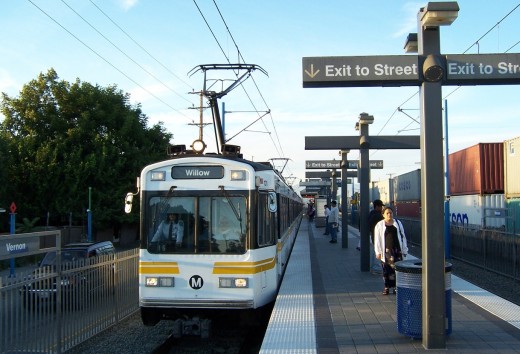
Over a two-decade period, in a total of 842 accidents, some 26 motorists were killed in collisions with Blue Line trains and 51 pedestrians accidentally struck and killed by trains. Fortunately, improved safety features, including the installation of four-quadrant crossing gates at several of the worst intersections, have improved the Blue Line's safety record substantially — resulting in a 73% drop in the accident rate to only about one-fourth the rate first experienced when the line opened in 1990.
• Miami area's South Miami-Dade Busway — This 13-mile (21-km) busway, created in 1997 by paving over an abandoned Florida East Coast Railroad line, provides a "BRT" service between Florida City and the Dadeland South Metrorail Station (Metrorail is the Miami area's mostly elevated rail rapid transit system). However, virtually from its inception, the busway has experienced safety problems, mainly in the form of collisions with private motor vehicles on thoroughfares that cross the transit alignment (there are technical and sometimes legal limitations that have often constrained the deployment of railway-type crossing gates on busways). As Wikipedia summarizes the situation,
The Busway has been the site of many accidents, as some car drivers driving south on US-1 (which runs parallel to the Busway for much of its length), and looking to turn west, do not stop at the red arrows that govern the right turn lane at an intersection that has a Busway crossing adjacent to it. They make a right turn and go right into the path of a bus that is entering the adjacent Busway intersection. Buses currently have to slow down to 15 mph (24 km/h) before crossing the intersection, and the police often patrol the intersections looking for red arrow runners. Surprisingly, even the intersections where the Busway runs as far as 2 blocks west of US-1 suffer the same problem, with car drivers either not seeing or flatly ignoring the red lights at SW 184th and 186th Streets.
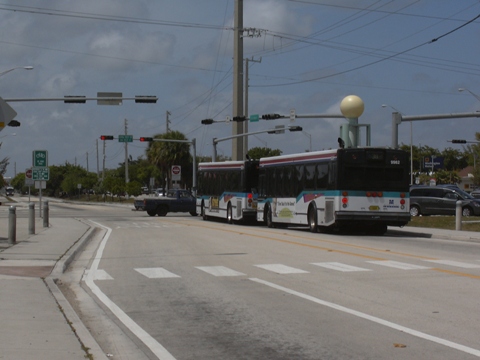
Apparently, buses have been required to stop at intersections, thus degrading their operating speed. It's likely that this has improved the line's safety record, although specific data on this are not readily available.
• Houston's MetroRail — Opened in 2004, MetroRail is a 7.5-mile (12.1-km) LRT line currently stretching southward from the University of Houston's Downtown campus to the Fannin South station. Ranking as the USA's fourteenth most-traveled LRT system, carrying the nation's second-highest ridership per track-mile, MetroRail's weekday ridership averages about 34,100.
Since its inception, however, MetroRail has been plagued by accidents, mainly collisions with motorists at intersections along its reservations located in major thoroughfares. MetroRail supporters have also noted that even before MetroRail entered service in 2004, the Main Street corridor of the LRT alignment had an extraordinarily high accident rate.
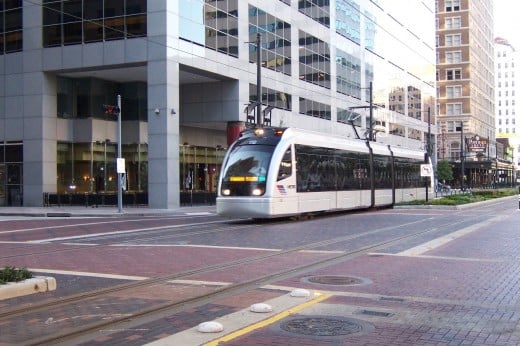
Driver error has consistently been cited as the cause of the system's early high collision rate. Later in 2004, after the line's opening and months of experience with collisions, an independent panel of Texas A&M University transportation experts reported finding no fundamental flaws with the Metrorail system, but did recommend important safety improvements such as special signage and signal timing changes.
According to one news report, accidents during approximately the first year and a half of operation have been blamed almost entirely on either motorists making illegal turns or running red lights, or pedestrians getting too close to the tracks. Another report cites red-light-running as the main problem downtown, and illegal turns the main cause near the Texas Medical Center area.
In part as a result of implementing recommendations from the Texas A&M investigation, MetroRail's safety record improved dramatically. By 2007, according to one analysis, the number of crashes per year had plummeted by 77%.
• Los Angeles's Orange Line Busway — This "BRT" line, launched in 2005, runs 14.0 miles (22.5 km) in a dedicated right-of-way (a former railway alignment) from the North Hollywood station of the Red Line rail rapid transit metro line through the San Fernando Valley westward to Warner Center in the Woodland Hills suburban area. According to Wikipedia, it too was plagued early on by several collisions at intersections, caused by illegal turns and red-light-running. In an effort to improve safety, the MTA installed white strobe lights on the sides of the buses to upgrade their visibility, and ordered all buses in the busway to slow down at intersections. This has degraded service slightly, but while specific safety data are not available, these measures have almost surely improved safety.
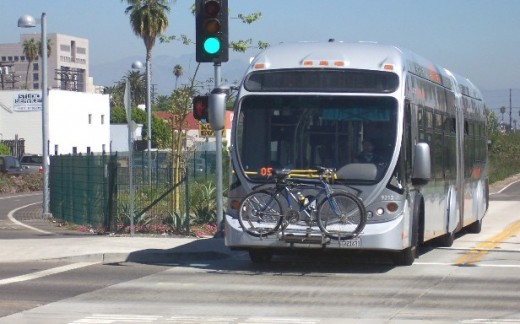
Safety on intercity railroad lines
In some cases, new LRT lines (or regional passenger rail trains) are routed predominantly in the same basic alignment as long-established, familiar freight railroad trains. The public may be accustomed to the freight operations, but the passenger services tend to be significantly faster, quieter, and more frequent, especially during daylight hours. In addition, in some cases there may be significant speed increases in freight rail operations (because of improvements to the alignment).
These problems besetting fast surface transit operations — particularly with motorists and pedestrians crossing tracks despite signals, crossing gates, and warning devices indicating danger — also jeopardize the safe operation of intercity passenger trains (almost always Amtrak) in metro areas. The major problem is that, in contrast to European practice, American transportation officials have generally given no thought to the safety implications of allowing new level crossings to be laid (or expanded) across surface tracks, whereas grade separations (under- and overpasses) are commonplace throughout Europe.
The problem is serious. According the nationally renowned U.S. rail safety program Operation Lifesaver, every three hours a person or vehicle is hit by a train. Over the past three decades, however, in part because of enhanced attention to safety, the annual number of collisions has declined dramatically — from 9,461 in 1981 to 1,956 in 2011.
Another persistent problem in rail safety is that young people are not routinely taught in school (as they were decades ago) about the dangers of crossing or walking along railroad and railway tracks. Consequently there are numerous railroad track accidents, often tragic, involving youths. Some of the more common safety violations include:
• Youths getting caught by trains as they're walking over narrow trestles on active railroad lines
• Youths being struck because they were wearing earbuds or headphones, listening to loud music, and thus failing to hear an approaching train
• Youths oblivious to approaching trains, either as they cross tracks or walk along them, because of talking or texting with a cellphone (at least one heartbreaking case, in Austin, Texas, involved a deaf young woman texting as she walked in the tracks of the main line of a major heavy-traffic railroad, with a train approaching behind her)
• Youths lying down in tracks, sometimes falling asleep, in some cases after using alcohol or recreational drugs.
In the context of today's obsession with austerity in government funding, and a tendency to disparage the role of any government programs, the outlook for aggressively upgrading rail safety through vigorous government action is not currently propitious. However, this could change with a shift in political orientation on the American landscape. By making their opinions heard, segments of the public to whom rail safety is a strong concern could influence major new policy initiatives in the event that major political upheavals do occur.
Lyndon Henry is a writer, editor, freelance investigative journalist and analyst, and transportation planning consultant. He produces the Writing Perspectives blog:
http://writingperspectives.wordpress.com
Originally published: 2012/03/20

